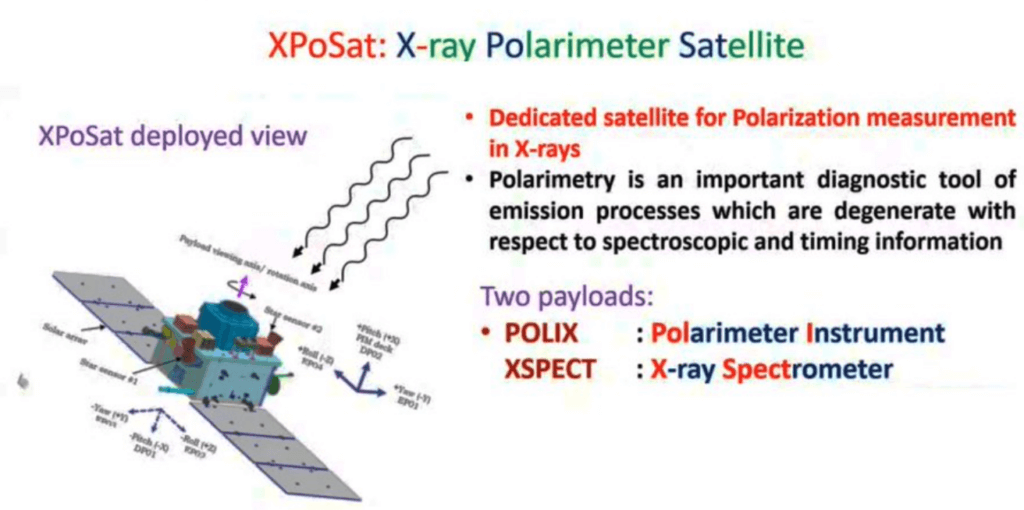Daily Current Affairs : 20-November-2023
In a historic breakthrough, researchers from the Indian Institute of Technology (IIT) Guwahati and the UR Rao Satellite Centre of ISRO have achieved a significant discovery by detecting polarized emissions from an extragalactic black hole, a feat marking the first such observation beyond our Milky Way Galaxy.
Exploring the Binary Star System: Large Magellanic Cloud X-3 (LMC X3)
The research team focused their efforts on studying the binary star system known as ‘Large Magellanic Cloud X-3 (LMC X3),’ comprising a black hole and a massive star. Utilizing X-ray polarimetry, they employed NASA’s Imaging X-ray Polarimetry Explorer (IXPE) and other missions to unravel the mysteries hidden within this celestial duo.
- Insights Unveiled: The findings gleaned from IXPE offer unprecedented insights into the nature of astrophysical black hole sources, shedding light on their intricacies and behaviors.
NASA’s Pioneering Mission: IXPE
- Significance of IXPE: NASA’s Imaging X-ray Polarimetry Explorer (IXPE) played a pivotal role in this groundbreaking discovery. As the first mission dedicated to studying the polarization of X-rays from celestial objects, IXPE paved the way for a deeper understanding of the cosmos.
ISRO’s Next Leap: X-ray Polarimeter Satellite (XPoSat) Mission
- Advancements on the Horizon: The success of this mission sets the stage for ISRO’s upcoming X-ray Polarimeter Satellite (XPoSat) mission. This satellite, equipped with the capability to study X-ray polarization, represents a significant stride in India’s space exploration endeavors.

Unraveling the Mystery: What is Polarized Emissions?
In the realm of astrophysics, polarized emissions involve electromagnetic waves, such as light or X-rays, with electric field vectors oscillating predominantly in a specific direction. Detecting polarized emissions from celestial objects, including black holes, serves as a valuable tool for unraveling crucial information about their physical properties and the surrounding cosmic environment.
Important Points:
- Groundbreaking Discovery Beyond Milky Way:
- Researchers from IIT Guwahati and ISRO detect polarized emissions from an extragalactic black hole.
- First-ever observation of such phenomena beyond our Milky Way Galaxy.
- Binary Star System Exploration: LMC X3:
- Focus on the binary star system ‘Large Magellanic Cloud X-3 (LMC X3)’ containing a black hole and a massive star.
- Utilization of X-ray polarimetry with NASA’s IXPE mission to study the system.
- Findings offer unprecedented insights into the nature of astrophysical black hole sources.
- NASA’s IXPE Mission: Pioneering Polarimetry:
- IXPE, NASA’s Imaging X-ray Polarimetry Explorer, plays a pivotal role.
- First mission dedicated to studying X-ray polarization from celestial objects.
- Significance lies in providing deeper understanding of the cosmos.
- ISRO’s Upcoming XPoSat Mission: Advancements on the Horizon:
- ISRO’s X-ray Polarimeter Satellite (XPoSat) mission is set to follow IXPE.
- XPoSat will be the second satellite with the capability to study X-ray polarization.
- Represents a significant stride in India’s space exploration endeavors.
- Polarized Emissions: Key to Astrophysical Insights:
- Polarized emissions involve electromagnetic waves, such as light or X-rays, with specific oscillation directions.
- Detection of polarized emissions from celestial objects, like black holes, provides valuable information about their physical properties and surrounding environment.
Why In News
Researchers from the Indian Institute of Technology (IIT) Guwahati and the UR Rao Satellite Centre of ISRO have achieved a groundbreaking discovery by detecting polarized emissions from an extragalactic black hole (i.e., outside our Milky Way Galaxy), marking the first such observation beyond our Milky Way Galaxy. This significant milestone opens new avenues for studying the unique properties of black holes in diverse cosmic environments, expanding our understanding of the broader universe.
MCQs about A Cosmic Breakthrough in Black Hole Exploration
-
What did researchers from IIT Guwahati and ISRO achieve in the groundbreaking discovery ?
A. Detected polarized emissions from the Milky Way Galaxy
B. Studied binary star system in a distant galaxy
C. Explored gravitational waves in our solar system
D. Investigated radio emissions from the LMC X3 system
-
What is the significance of NASA’s Imaging X-ray Polarimetry Explorer (IXPE) mission in the context of the essay?
A. Studying gravitational fields in space
B. Investigating the polarization of X-rays from celestial objects
C. Mapping cosmic dust particles
D. Observing solar flares on the Sun
-
What role does ISRO’s upcoming X-ray Polarimeter Satellite (XPoSat) mission play ?
A. Observing planetary atmospheres
B. Studying gravitational lensing effects
C. Second satellite with X-ray polarization capabilities
D. Analyzing cosmic microwave background radiation
-
What do polarized emissions from celestial objects, such as black holes, provide in astrophysics?
A. Information about star formation
B. Insights into dark matter composition
C. Valuable information about physical properties and the environment
D. Study of cosmic rays in interstellar space
Boost up your confidence by appearing our Weekly Current Affairs Multiple Choice Questions
![]()


